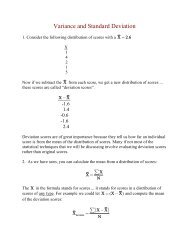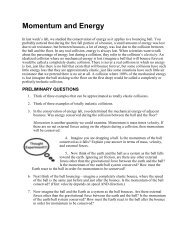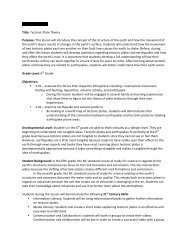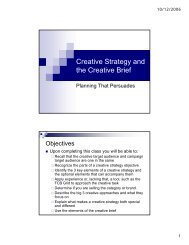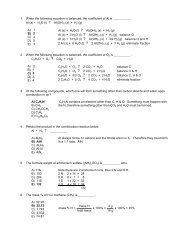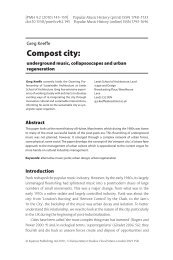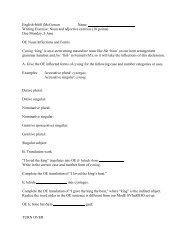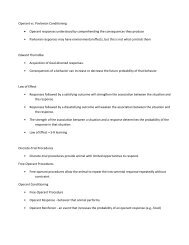Create successful ePaper yourself
Turn your PDF publications into a flip-book with our unique Google optimized e-Paper software.
<strong>Specific</strong> <strong>Heat</strong> <strong>Capacity</strong><br />
INTRODUCITON<br />
<strong>Heat</strong> (symbolized by Q) is a form of kinetic energy produced by the motion of atoms and<br />
molecules and is transferred from one body or system to another due to a difference in<br />
temperature. This energy is transferred from a hotter object to a cooler object. In order for energy<br />
to be conserved, the amount of heat energy lost by the hotter object plus amount of heat energy<br />
gained by the cooler object must be equal to zero.<br />
ΔQ H + ΔQ C = 0 (Eq. 1)<br />
The subscripts H and C indicate the hot and cold object. The amount of heat energy an object can<br />
absorb or release (ΔQ) is directly related to the following factors: how much mass the object has,<br />
how easy/hard it is for the material to absorb/release heat energy (otherwise known as the<br />
specific heat = c), and how much the object’s temperature changes (ΔT).<br />
ΔQ = mcΔT = mc (T f – T i ) (Eq. 2)<br />
When two objects come to a thermal equilibrium, that means that they have the same final<br />
temperature. The cool object gains the heat energy that the cool object loses. Therefore, the<br />
conservation of energy equation may be rewritten as follows:<br />
[m H c H (T f – T H )] + [m C c C (T f – T C )] = 0 (Eq. 3)<br />
The specific heat capacity (c) indicates amount of energy (in Joules) required to raise the<br />
temperature of 1 kg of a particular material by 1 degree Celsius. Its units are J/(kgºC). The<br />
specific heat is a property of the material and every substance has a different specific heat. It<br />
takes a different amount of energy to raise the temperature of 1 kg of each material by 1 ºC.<br />
More energy is required to increase the temperature of a substance with high specific heat than<br />
one with low specific heat. For example, the specific heat of water is 4186 J/(kgºC). This means<br />
that it takes 4186 Joules to raise the temperature of 1 kg of water by 1 ºC. In fact, water is one of<br />
the more difficult materials to change the temperature of. A short list of specific heat values is<br />
included in Table 1.
Table 1. <strong>Specific</strong> heat of common materials<br />
Reminder: Record in your lab report ALL measured values. Be sure to include what instrument<br />
you measured it with, the units, and the estimated error, and the instrument the measurement was<br />
made with. When performing a calculation be sure to always write the equation used first, then<br />
insert the values AND THEIR UNITS, then show your work in solving the equation including<br />
any unit conversions.<br />
PRELAB QUESTIONS<br />
Aluminum Water Copper Tin Iron<br />
c [J/kgºC] 900 4186 386 227 450<br />
1. If you have 1.0 g of water and 1.0 g of aluminum both at 20.0 ºC, which would need to<br />
receive more energy to increase its temperature to 21.0 ºC Explain.<br />
2. If you have 1.0 g of water and 5.0 g of aluminum both at 20.0 ºC, which would need to<br />
absorb more energy to increase its temperature to 21.0 ºC Explain.<br />
3. If you mixed 0.200 kg of water at 30.0 ºC with 0.400 kg of water at 50.0 ºC, what would<br />
be the temperature of the mixture<br />
4. You have .070 kg of an unknown sample that is at 96.0 ºC. You drop it into 0.150 kg of<br />
water that is at 20.0 ºC. After a few seconds, the temperature of the water stabilizes at<br />
23.6 ºC. Which of the materials in Table 1 is the unknown sample most likely to be<br />
MATERIALS<br />
Styrofoam container<br />
Two cups<br />
Metal Samples<br />
Thermometer<br />
Mass balance<br />
ACTIVITY I: Determining the final temperature of a water mixture.<br />
5. In this activity you will use Eq. 3 to predict the final temperature of a mixture of hot<br />
and cold water. Start with around half a cup of cool water from the water fountain<br />
around half a cup of hot water from the sink. (Let the hot water run until it is really<br />
hot!) Do not mix the water yet. First determine what quantities must be known in<br />
order to make an informed prediction of the final temperature. If you need to make
any measurements, remember to also record the units, the uncertainty, and the<br />
measuring device that you used. Also remember to calibrate and zero any measuring<br />
device before using it.<br />
6. Given what you have measured, rearrange Eq. 3 to predict the final temperature of the<br />
water mixture. Show your work!<br />
7. Pour the contents of the beaker into the Styrofoam container and stir with the<br />
thermometer. Record the highest temperature reached by the mixture. Using percent<br />
difference, compare your measured value to your predicted value. Explain any<br />
differences in your error analysis.<br />
ACTIVITY II: Determining the specific heat of a metal sample.<br />
QUESTIONS<br />
8. In this activity you will use Eq. 3 to determine the specific heat of a metal cylinder.<br />
You will heat the cylinder in a beaker of hot water from the sink, then quickly<br />
transfer the cylinder to a Styrofoam container of cool water, stirring with the<br />
thermometer until the water and the sample have reached a final equilibrium<br />
temperature. The Styrofoam container must contain enough water to completely<br />
cover the metal cylinder. As in Activity I, determine, measure, and record the<br />
quantities that must be known in order to make a determination of the specific heat of<br />
the sample.<br />
9. Given what you have measured, rearrange Eq. 3 to determine the specific heat of the<br />
metal. Show your work!<br />
10. According to Table 1, what type of metal is the sample most likely made of Do you<br />
agree Compare the specific heat you calculated to the value in the table using<br />
percent difference.<br />
11. Was all of the heat energy of the metal sample actually transferred to the water<br />
Explain.<br />
12. Where could the heat have gone If energy was somehow lost, would this cause your<br />
determination of specific heat to be higher or lower than the predicted value Explain.


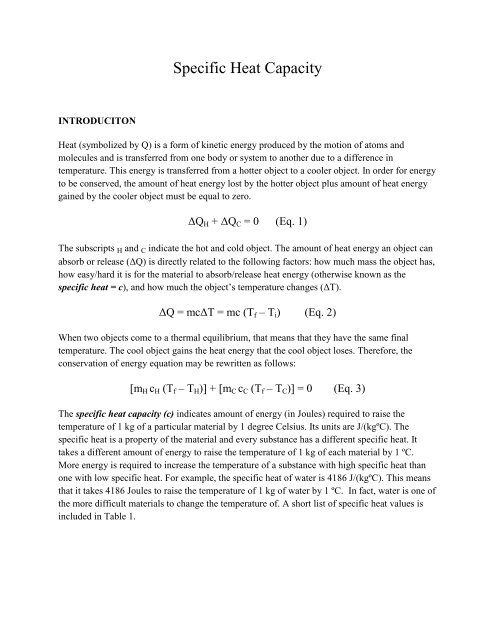
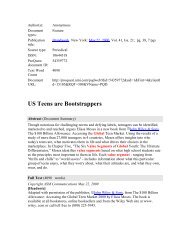

![Graduate Bulletin [PDF] - MFC home page - Appalachian State ...](https://img.yumpu.com/50706615/1/190x245/graduate-bulletin-pdf-mfc-home-page-appalachian-state-.jpg?quality=85)
